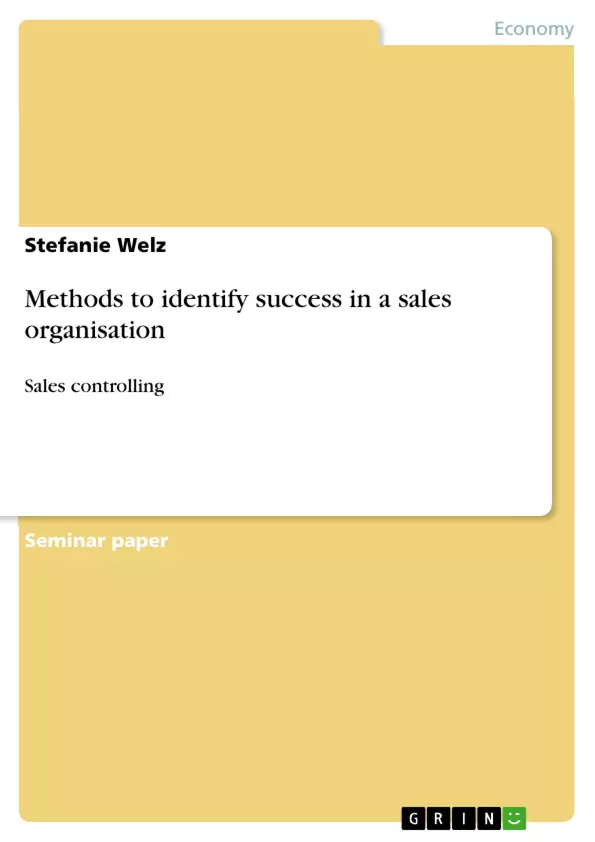1 Introduction
1.1 Executive Summary
Over the past years the company’s environments are getting more and more manifold and complicated. New, flexible forms of sales, E-Commerce and growing IT-know-how as well as an increasing change in customer preferences and requirements on the world market lead to modified tasks of sales representatives and increasing importance of sales organizations within the companies. According to a research of the consultancy firm Mercuri International1 most of the interviewed companies forecasted that the expansion of distribution channels, the improvement of existing sales concepts, international sales activities and further sales controlling are the key issues for the future.
1.2 Scope of Work
The assignment “Methods to identify success in a sales organization - sales controlling” starts with the introduction which includes the executive summary and the scope of work that is realized in here.
The second chapter deals with a detailed definition of the problem that causes the relevance of this assignment, the determination of the objectives as well as the methodology that describes the assignment’s structured procedure. Chapter three is focused on the basics of sales and controlling. At this juncture in particular sales, controlling and sales controlling are being analyzed. Chapter four is about the objectives and tasks of sales controlling where as chapter five describes the different methods of sales controlling.
Finally, the results of this assignment are summarized; especially whether the set objectives are reached as well as critical comments about the assignment is given in the last chapter. The purpose of this assignment is to provide further research insight on a topic, which still has not yet reached saturation in terms of analysis and understanding even though there is a voluminous literature on sales controlling.
Inhaltsverzeichnis (Table of Contents)
- Introduction
- Executive Summary
- Scope of Work
- Problem and Research
- Problem Definition
- Relevance and Motivation
- Methodology
- Basics on sales and controlling
- Sales
- Controlling
- Origin
- Characteristics
- Sales controlling
- Operative sales controlling
- Strategic sales controlling
- Objectives and Tasks of Sales Controlling
- Objectives of Sales Controlling
- Tasks of Sales Controlling
- Methods of sales controlling
- Distribution cost accounting
- Sales income statement
- Analysis of sales channels
- Management of sales representatives
- Reporting of sales force
Zielsetzung und Themenschwerpunkte (Objectives and Key Themes)
This assignment "Methods to identify success in a sales organization - sales controlling" aims to explore the critical role of efficient sales controlling in achieving corporate success. It examines the importance of well-implemented and managed sales controlling for achieving corporate success, explaining methods for management critically.
- The growing significance of sales and distribution achievement in modern enterprises.
- The importance of implementing efficient sales controlling to manage sales and distribution departments.
- The objectives pursued by well-implemented sales controlling.
- The specific tasks performed by an efficient sales controlling function.
- The various methods employed by effective sales controlling.
Zusammenfassung der Kapitel (Chapter Summaries)
The introduction provides an overview of the assignment, outlining its scope and purpose. It highlights the increasing complexity of company environments and the growing importance of sales organizations. Chapter 2 delves into the problem definition, emphasizing the critical role of sales and distribution departments in achieving corporate success. It explains the motivation behind the assignment and the need for a well-structured methodology. Chapter 3 focuses on the fundamental concepts of sales and controlling, examining sales controlling as a key element in achieving corporate goals. Chapter 4 delves into the specific objectives and tasks of sales controlling, outlining its role in managing and optimizing sales activities. Chapter 5 explores the various methods employed by sales controlling, such as distribution cost accounting, sales income statement analysis, and sales force management.
Schlüsselwörter (Keywords)
The primary keywords and focus topics include: sales controlling, corporate success, customer relationship management, sales and distribution, efficiency, objectives, tasks, methods, distribution cost accounting, sales income statement, analysis of sales channels, management of sales representatives, reporting of sales force, and corporate goals.
- Citar trabajo
- Stefanie Welz (Autor), 2006, Methods to identify success in a sales organisation, Múnich, GRIN Verlag, https://www.grin.com/document/73461



